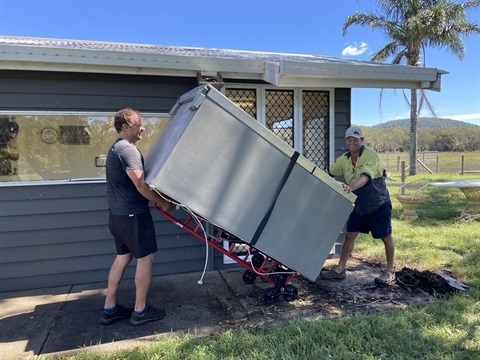Safely cleaning your home after a flood
Published on 01 April 2022

Kempsey Shire Council has compiled a list of some practical ways to keep you safe when cleaning in and around your house after a flood.
Household clean-up
- Wear protective clothing, including boots, gloves and eye protection.
- Check for snakes and other wildlife that may have taken refuge in your home.
- Remove all wet items from the house as soon as possible, including carpets, rugs, furniture, bedding and clothing.
- Use a hose to wash mud and debris from a house, starting at the highest point and moving downwards.
- Open doors and windows to dry out the interior of the house. You can also use fans if these have not been exposed to floodwater.
- Wash your hands well after any flood clean-up activities.
For more information click here
Cleaning kitchens and food utensils
It’s important to thoroughly clean and sanitise kitchen items and food utensils that have been exposed to floodwater as it often contains hazardous substances such as sewage.
- wash utensils in hot, soapy, drinking-quality water
- sanitise metal items by boiling them in water for 10 minutes
- throw away items made from wood, plastic, rubber or other porous materials, since it is not possible to adequately sanitise these.
For more information click here
Flood-affected food
Food that’s come into contact with floodwater may be unsafe to eat. This is because floodwater often contains contaminants such as sewage or agricultural and industrial waste.
- throw out food that has come into contact with floodwater or has an unusual colour, odour or texture
- inspect canned food and discard cans that are dented, swollen or damaged
- wash and dry your hands thoroughly with soap using clean, drinking-quality water after handling items that have been in floodwater
- use an alcohol-based hand sanitiser to clean your hands if you have a limited supply of drinking-quality water.
For more information click here
Septic tanks
If your property was flooded, your septic tank system (or onsite wastewater system) may have been damaged.
Signs your system may be damaged include:
- a pungent odour
- high sludge levels in the primary tank
- blocked fixtures and wastewater overflowing from the relief point
- sewage flowing up through the toilet and sinks.
If you suspect your system is damaged, you should arrange for a licensed plumber to assess its condition.
For more information click here
Rainwater tanks
If your property has been affected by flooding, you may be wondering about the condition of your rainwater tank.
It is not usually necessary to empty a tank unless it has been inundated by flood water.
For advice on maintaining or disinfecting your rainwater tank, click here
Cleaning up a swimming pool
There are several steps you should take to make sure your pool is safe for use after a flood.
- Engage a licensed electrician to check electrical components such as the pump.
- Arrange for pool fences that have been damaged or washed away to be rebuilt or repaired.
- Check the pool environment for hazards such as snakes and debris such as wire.
- Avoid immediately pumping the water out of the pool, as this could worsen structural damage or expose hazardous material that has been washed into the pool.
- Check the pool regularly to ensure it doesn’t become a breeding ground for mosquitoes.
- Avoid turning on the filter to clean dirty pool water; instead, consult a pool shop for advice on how to ‘flocculate’ and restore the water.
For more information click here
Home vegetable gardens
If your property has been flooded, your vegetable garden may have been contaminated with sewage and other hazardous substances.
It is advisable not to harvest vegetables or herbs for at least a month after flooding. You should also discard all leafy green vegetables.
After one month, vegetables can be sanitised in a weak bleach solution (1 tablespoon bleach to 2 litres of water) and then washed before use.
For more information click here